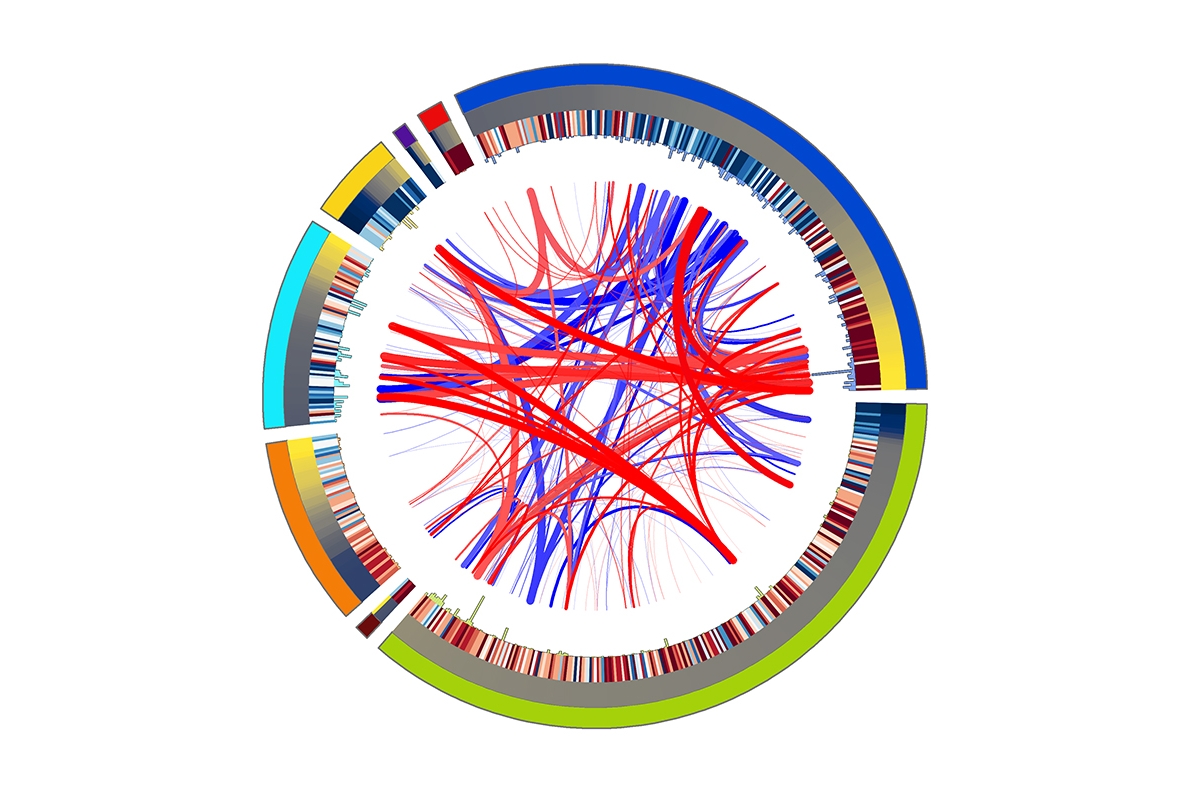A study led by researchers at Memorial Sloan Kettering Cancer Center (MSK) and Weill Cornell Medicine discovered a new relationship between cancer cells and the immune system, and shows how cancer can selfishly hijack a normally helpful immune pathway.

Dr. Samuel Bakhoum
Usually, activation of this key immune pathway — called the STING pathway — triggers a strong inflammatory response that protects the body from foreign and unhealthy cells. But prolonged activation of the same pathway leads to a desensitization and ultimately to a “rewiring” of cellular signaling, which aids and abets cancer’s spread, the researchers found.
“You might think of it like a car alarm,” said Dr. Samuel Bakhoum, a researcher and radiation oncologist at MSK, and one of the study’s two senior authors. “If it goes off rarely, that’s going to get your attention. But if it’s going off all the time, you’re going to get used to it and tune it out.”
The findings, which were published Aug. 23 in Nature, help explain why drugs to activate STING (known as STING agonists) have been unsuccessful in clinical trials in patients with advanced cancer, and suggest, counterintuitively, that many patients may actually benefit from drugs that block STING activation (STING inhibitors).
“There’s been millions of dollars invested in drugs that activate the STING pathway to fight cancer, and so far in clinical trials, they have not shown significant anti-cancer efficacy,” Dr. Bakhoum said. “In the lab, these drugs held a lot of promise — but in one trial of 47 patients, there were only two whose cancers even showed a partial response. In another trial of more than 100 patients that combined STING agonists with another immunotherapy, the overall response rate was 10 percent. So the question driving this research was, ‘Why don’t they work despite such promise in the preclinical setting?’”

Dr. Ashley Laughney
The team’s discoveries were made possible through the development of an innovative computational tool in the lab of the study’s other senior author, Dr. Ashley Laughney, an assistant professor of physiology and biophysics and member of the Institute for Computational Biomedicine at Weill Cornell Medicine. Dubbed ContactTracing, the approach predicts cell-to-cell interactions and also examines how different cells respond to stimuli in growing tumors. By mapping interactions into a mandala-like pattern, the tool revealed that the long-term activation of the STING pathway leads to changes in cellular signaling that attracts cells that suppress the immune response to the area in and around the tumor.
“This isn’t just another tool to document whether cell type A might interact with cell type B,” said Dr. Laughney, who is also a member of the Sandra and Edward Meyer Cancer Center at Weill Cornell Medicine. “We're looking at whether and how these interactions actually affect the cell receiving the signal.”
The study was led by a team of four co-first authors from the Bakhoum and Laughney laboratories: postdoctoral fellow Dr. Jun Li and senior research technician Mercedes Duran from the Bakhoum Lab; and computational scientist Dr. Melissa Hubisz and Tri-Institutional Computational Biology and Medicine graduate student Ethan Earlie from the Laughney Lab.
When Cell Division Goes Haywire
Central to the research is a phenomenon known as chromosomal instability.
“It’s a feature of cancer, especially advanced cancers, where the normal process of cell division goes haywire,” said Dr. Bakhoum, whose lab is part of the Human Oncology and Pathogenesis Program at MSK.
If the chromosomes are the instruction manual for the body, it’s like having some cells that wind up with a lot of duplicated and/or missing pages, he explains.
“We knew that chromosomal instability is an important driver of cancer’s ability to spread, otherwise known as metastasis,” Dr. Bakhoum said. “What we discovered here is that the immune system plays a central role in this process.”
Cooperation Between Cancer Cells and the Immune System Is Driven by STING
A previous collaboration between researchers at MSK and Weill Cornell Medicine, which was also published in Nature, showed the complex chain of events triggered by chromosomal instability leads to changes in cells that drive cancer metastasis.
“That study was done in partially immune-compromised mice,” Dr. Bakhoum said. “So it was really neither here nor there in terms of understanding the role of the immune system.”
To figure out the immune system’s role, the new study used mouse models of cancer that either had fully functional immune systems or greatly weakened immune systems. It also looked at tumor cells with both high and low levels of chromosomal instability, as well as cells missing the STING1 gene, which makes a protein called STING, that activates an inflammatory response when it detects foreign DNA molecules in the cytoplasm.
“What we found was that the effect was largely dependent on the immune system,” Dr. Bakhoum said. “Basically, there is sinister cooperation between cancer cells with chromosomal instability and immune cells — and that cooperation is driven by STING.”
The results from mouse models of cancer were then validated in healthy cells and tumor samples from human patients.
For example, the researchers treated a simple type of cell, known as a fibroblast, with a STING agonist — the foundation for the drugs developed for human patients — and observed a strong initial immune response.
“But by day five, you have basically no immune response left,” Dr. Bakhoum said. “The cells became desensitized to this pro-inflammatory pathway very quickly — mirroring the response we saw in the cancer cells. Instead, the cells started to signal stress response pathways that dampened the immune response, thus having the opposite effect.”
Digging Into Complex Cell-to-Cell Interactions
The scientists used a technique called single-cell sequencing to understand all the different cellular players in and around a tumor (also called the tumor microenvironment). The technique allows for the detailed analysis of all the many types of cells involved — such as macrophages, T cells, B cells, neutrophils and tumor cells — and the ligands and receptors they express. Notably, to communicate, cells typically emit ligands that bind to complementary receptors on the surface of target cells, thereby triggering a change in the behavior of the target cell. While most methods predict cell-to-cell interactions based on just the mutual expression of complementary ligand-receptor pairs, the research team focused on whether their interaction actually changes the cell receiving the signal.
“One of our most important findings was that altering the level of chromosomal instability or the activation of STING dramatically changes responses in the environment in and around the tumor,” Dr. Laughney said.
And to understand those impactful interactions between the cancer cells and different immune cells, the researchers developed ContactTracing. By design, the tool exploits the variability of real-world biology without the need for prior knowledge.
The method is based on the simple premise that in a given tumor, there is inherent biological diversity — not every cancer cell is going to secrete the same binding molecule, or ligand. And not every immune cell is going to express the right receptor for that ligand, Dr. Laughney explained.
So, by comparing cells that are interacting to ones that aren’t, the tool gives scientists a clearer picture of what exactly is changed by the interaction between the two.
“When you look at the effects that elicit a response in the cancer microenvironment, all the ligands on those chromosomally unstable cancer cells were associated with a specific cellular stress response — one that happens to involve STING,” she said.
And when the same interactions were examined in the context of low chromosomal instability or where STING had been depleted from cancer cells, they trigger a different response — a strong immune response that attacked the cancer cells.
The new ContactTracing method could also help illuminate other areas of biology and disease where cell-to-cell interactions are critical, Dr. Laughney noted.
Findings Suggest Therapeutic Opportunities
The findings from the study suggest an opportunity to improve treatments for the many patients with advanced cancer driven by chromosomal instability, Dr. Bakhoum said.
“It appears the reason activating STING in these patients isn’t very effective is that most patients’ cells are already desensitized to it due to the persistent activation of the pathway from chromosomal instability,” he said. “Counterintuitively, these patients may actually benefit from STING inhibition.”
Treatment of study mice with STING inhibitors reduced chromosomal instability-driven metastasis in melanoma, breast, and colorectal cancer models.
Additionally, by identifying the subset of patients whose tumors can still mount a strong response to STING activation, doctors could select better candidates for STING agonists, Dr. Bakhoum said.
Additional Authors, Funding, and Disclosures
Additional authors on the study include Julie-Ann Cavallo, Christy Hong, Atif J. Khan, Emanuele Lettera, Simon Powell, Jorge S. Reis-Filho, and Hannah Wen, of MSK. Karolina Budre, Matthew Deyell, Erina Kamiya, and Austin A. Varela, of Weill Cornell Medicine. Sarah Bettigole, Jonathan J. Havel, and Bernardo Tavora, of Volastra Therapeutics. Eileen E. Parkes and Su M. Phyu, of Oxford University. Amit Dipak Amin and Benjamin Izar, of Columbia University. And Christopher Garris, of Harvard University.
The study was supported by the National Institutes of Health and National Cancer Institute (P50CA247749, DP5OD026395, R01CA256188, P30-CA008748, R01CA256188, R01CA280414, R01CA280572, U01CA210152, R21-CA266660, R37CA258829, R21CA263381, R01CA280414, R01CA266446, P50CA247749); Congressionally Directed Medical Research Program (BC201053); the Burroughs Wellcome Fund; the Josie Robertson Foundation; the Cycle for Survival Fund; a Kellen Junior Faculty Award; the Melanoma Research Alliance; the Lung Cancer Research Foundation; the Pershing Square Sohn Cancer Research Alliance; the Tara Miller Melanoma Research Alliance; the V Foundation; the Oxford Institute for Radiation Oncology; the Prostate Cancer Foundation; the Wellcome Trust; the American Society of Clinical Oncology; the Academy of Medical Sciences; the Breast Cancer Research Foundation; a Susan G. Komen Leadership Grant; and a STARR Cancer Consortium grant.
Dr. Bakhoum holds a patent related to some of the work targeting chromosomal instability and the STING pathway in advanced cancer. He owns equity in, receives compensation from, serves as a consultant for, and serves on the Scientific Advisory Board and Board of Directors of Volastra Therapeutics, and he serves on the Scientific Advisory Board of Meliora Therapeutics.
Dr. Parkes, Dr. Izard, Dr. Wen, Dr. Reis-Filho, and Dr. Garris disclosed ties to the pharmaceutical and/or finance industries. Dr. Bettigole, Dr. Havel, and Dr. Tavora are employees of Volastra Therapeutics and own equity in the company.
This story first appeared on the MSK Newsroom.

